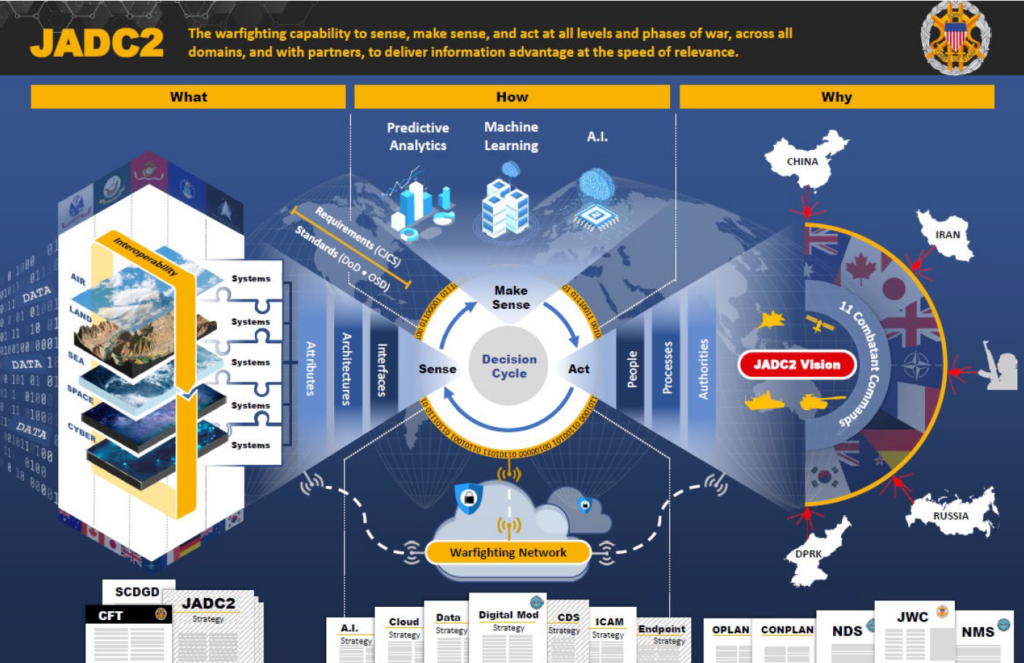

Awareness on the battlefield is essential for success. The ability to view data in real-time to provide the most current common operating picture (COP) showing friendly and enemy positions and activity on the battlefield across multiple domains. Accurate and timely information allows military commanders, as well as senior leaders in national security, to make better informed decisions.
Modern technology, increasing focus on a conflict escalating to a war with China and/or Russia, and reliance on allies and partners in geographic locations far from the continental US are a few of the factors driving requirements for the ability to communicate across all domains—ground, air, space, cyber, and maritime, communicating up, down, and all around the command chain, to the right and left with partners and allies—using the most current information from sensors to shooters to set conditions for success. The Department of Defense believes the solution lies in the Joint All Domain Command and Control (JADC2 – pronounced Jad-see-two), a concept to guide requirements for joint force command and control (C2) to be met by programs designed by the military services.
In March 2022, Deputy Secretary of Defense Kathleen Hicks signed the JADC2 Implementation Plan, a classified document detailing requirement planning and resourcing as well as identifying organizations delivering JADC2 capabilities. What is available for understanding the vision and approach for joint force C2 capabilities is a summary of the JADC2 Strategy. The strategy outlines five lines of effort (LOEs) to organize and guide actions. The LOEs are:
- Establish the JADC2 Data Enterprise;
- Establish the JADC2 Human Enterprise;
- Establish the JADC2 Technical Enterprise;
- Integrate Nuclear C2 and Communications (NC2/NC3) with JADC2; and
- Modernize Mission Partner Information Sharing.
Additionally, the Strategy provides six guiding principles to promote coherence of effort across the Department in delivering materiel and non-materiel JADC2 improvements. These principles are:
- Information Sharing capability improvements are designed and scaled at the enterprise level;
- Joint Force C2 improvements employ layered security features;
- JADC2 data fabric consists of efficient, evolvable, and broadly applicable common data standards and architectures;
- Joint Force C2 must be resilient in degraded and contested electromagnetic environments;
- Department development and implementation processes must be unified to deliver more effective cross-domain capability options; and
- Department development and implementation processes must execute at faster speeds.


JADC2 is not a program with a single dedicated line or program element in budget documents and the FY24 $1.4 billion dedicated to JADC2 briefed to the press and public on March 13, 2023 did not breakdown the overall figure. In a July 2023 talk entitled Funding JADC2 for Combatant Commanders – The Way Ahead at the National Defense Industrial Association’s 2023 JADC2: All Domain Warfare Symposium, Kathleen Miller, Deputy Under Secretary of Defense, Comptroller, provided more detail for the
$1.4 billion requested in FY24 for JADC2. According to National Defense, Miller explained the five areas totaling $1.4 billion:
$66 million in Research, Development, Testing and Evaluation (RDT&E) for the Army’s Project Convergence, $192 million for the Navy’s Project Overmatch, $500 million for the Air Force’s Advanced Battle Management System, $28 million for the defense-wide Joint Staff work to oversee Cross Functional Team efforts, and $615 million for work in the Chief Digital and Artificial Intelligence Office.
Miller noted sensors, radars and communications systems were not included in the $1.4 billion request.
With no single program element/budget line assigned to the effort in the Department of Defense Budget justification books, determining the full funding profile for JADC2 is challenging. Miller’s public comments outline the resources allocated to the effort. Spending is spread across at least six RDT&E program elements, one procurement line item and multiple O&M funding lines for exercises to test operational functions. In the press release for the JADC2 implementation plan, “details of plans of actions, milestones, and resourcing requirements” are in a classified document.
PROGRAM-LEVEL FUNDING
Each Service has its own effort within the JADC2 concept with some funding noted in budget materials.
The Army’s Project Convergence, experimental exercises guiding the Army’s journey to a data-centric force, has grown in scope and funding. Project Convergence 2024 will develop the Combined Joint Force’s ability to conduct offensive and defensive capabilities that can deter peer adversaries and, if necessary, defeat them in large scale combat operations.


Chart I. Source: DOD, FBIQ. *FY24 Senate Defense Appropriations Bill rescinds $25.5 million from FY23 funding.
In October 2020, then Chief of Naval Operations Admiral Mike Gilday, signed a memo standing up Project Overmatch and placing the Commander of Naval Information Warfare Systems Command, Rear Admiral Doug Small in charge of the effort. A companion memo gave Vice Admiral Jim Kilby, the deputy chief of naval operations for warfighting requirements and capabilities (OPNAV N9) the lead on a complimentary effort to accelerate unmanned capabilities development along with long-range fires. Project Overmatch has matured enough to provide a carrier strike group products developed from the effort.


Chart II. Source: DOD, FBIQ.
The Air Force’s Advanced Battle Management System (ABMS) is the Department of the Air Force’s sector for JADC2. Like the other service projects, ABMS aims to provide information across all domains in a contested environment. However, unlike the Army and the Navy, the Air Force has a dedicated program element/ budget line, making funding the most transparent of the three. The current iteration evolved in 2019 from the Airborne Battle Management and Surveillance system, a traditional acquisition program created in 2017 as an alternative to the Airborne Warning and Control System (AWACS) platform and the Joint Surveillance and Target Attack Radar System (JSTARS). The current ABMS has also evolved into a family of systems using non-traditional acquisition tools.


Chart III. Source: DOD, FBIQ.
WHAT’S AHEAD?
The Senate Appropriations Committee FY24 Defense Subcommittee (SAC-D) Report expresses frustration with the lack of budget transparency for JADC2. It creates a program element to capture funding requested throughout the thousands of pages of budget documents. A budget line for JADC2 can be found in RDT&E, Defense-Wide with $454 million transferred from the rapid prototyping program, Joint C5 Capability development, integration and interoperability assessments, and $235 million moved from the Chief Digital and Artificial Intelligence Officer in the Office of the Secretary of Defense. The new line also includes an additional $174 million for the Joint Fires Network, a high priority for the INDO-PACOM Commander.
The Committee finds the current funding structure for Defense-Wide JADC2-related investments to be diffuse, limiting oversight entities’ ability to clearly identify what discrete activities comprise JADC2 related work, and which officials are responsible for achieving the goals outlined in the Department’s JADC2 strategy.
SAC-D Report
The creation of a program element for JADC2 provides a way for Congress to track funding for a concept. There have been concepts in the past, the Army’s Future Combat System is an example, where billions of dollars were spent without much to show for the effort. Funding for JADC2 and the associated service projects will continue to rise as experimental exercises continue to expand and products move into the hands of the warfighter. If the department is concerned about placing too much information in the public domain, it may choose to provide classified JADC2 funding information to Congress for oversight.
Earlier this year, Lt. Gen. Mary O’Brien, director of C4 and cyber and chief information officer, J6 of the Joint Staff in a talk at the Potomac Officers Club, said the “acronym to look out for is “CJADC2,” reflecting a renewed emphasis on “combined” efforts with international partners as well as different military commands”. The “C” for combined has been added by other senior leaders but in this talk, the additional of the letter was clearly explained. Hopefully, this clarity can continue for CJADC2 in the future.